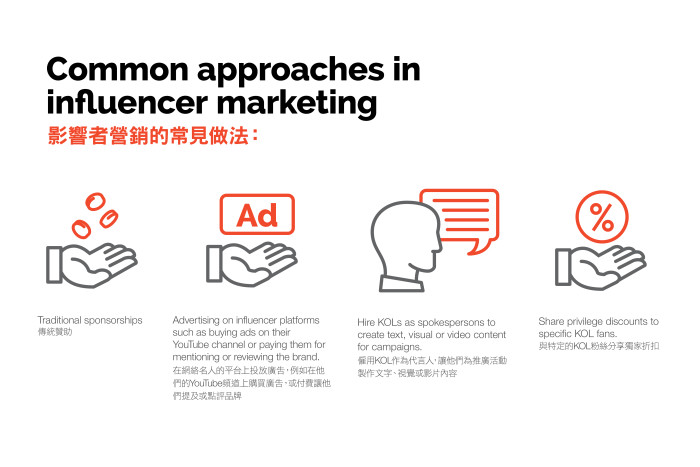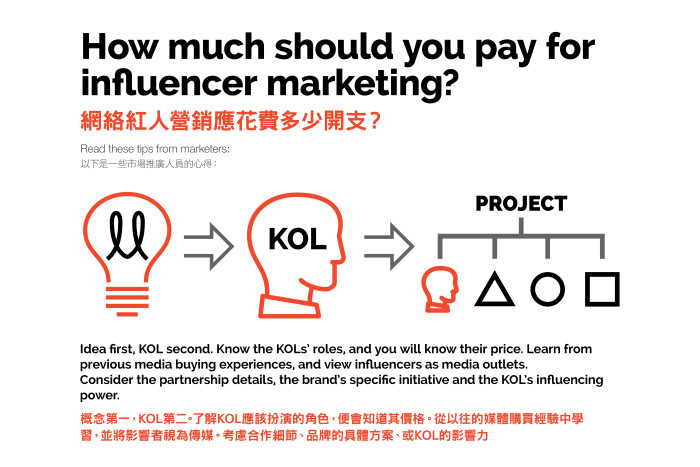
The numbers behind #KOL marketing
share on
The origin of internet influencers or key opinion leaders (KOLs) can be traced back to the heyday of the internet, when we browsed homemade blog posts on Xanga.com, blogger.com and other personal content-sharing platforms for leisure. Soon after, we noticed some bloggers standing out from their counterparts.
As social media rose to new heights in popularity, this new breed of digital content creators, especially ones who wrote about beauty, food, travelling, and leisure, quickly stole the limelight in the public arena.
In Hong Kong, for example, internet celebrity Tat Goh has amassed more than 114,000 fans on his Facebook page and 86,000 YouTube subscribers on his channel “UndergroundDV” for his daily live-gaming shows.
His rising fame attracted attention and landed him an opportunity to front Expedia Hong Kong’s digital and traditional commercials. Sponsorships from different brands contribute to him being able to make a full-time living as a key opinion leader. In 2014, he was even appointed vice-president of mobile game developer Ever App.
The KOL business is so profitable and promising that former news anchors and both major and minor celebrities are using their public social media accounts to share sponsored and non-sponsored posts to interact with their readers.
And it’s not just booming business for the KOLs themselves; brands are also excited about the new trend. Quickly looking through Hong Kong’s YouTube ads leaderboard shows that the majority of brands have hired familiar online infl uencers for their ads.
The case for KOLs
DBS Bank (Hong Kong) is one of the brands that actively embraces influencer marketing.It has increased its online and social media budget from 30% to about 50% of its total marketing budget in three years.
Glendy Chu, executive director and head of group strategic marketing and communications, says infl uencer marketing is not only part of the bank’s overall strategy, but one that has proven quite effective.
Defining KOLs as social media influencers who have a large group of fans who help brands boost social media engagement, she says DBS started testing the waters of influencer marketing with some of its branding campaigns in 2014. She says, eventually, that it “does serve as a smarter way to reach the customers”.
In one of its campaigns, the “Igniting Possibilities Sparking Joy” series, the bank teamed up with local influencers such as Daisy Wong to regularly spread the brand message that everyone should free themselves from their daily hassles, and discover their opportunities at the heart of who they are.
“We decided to ride on the trend when we saw more KOLs in product launches, and we did see its value,” she says.
“Celebrities may help brands to reach mass audiences, but KOLs are different in the way they deepen the reach. While KOLs usually make public their stances and attitudes, their followers usually pursue similar beliefs.
“By selecting the right KOL, we are able to not only cut through the clutter to reach more of the targeted market, but the audiences are also more keen to endorse our brand messages.”
Similarly, Wai Loi, marketing director for Huawei Hong Kong’s consumer business group, said Huawei has invested more of its marketing budgets in social media promotions. It began hiring more influencers as spokespersons for its gadget launch campaigns last year – and it’s seeing good value for money.
In its launch campaign for Huawei P9, the brand tapped Six Dimen Boy, several local Instagram photographers and actor Simon Yam to create visual stories for Hong Kong with the smartphone to highlight the capability of its camera.
Wai says the appeal of influencers just seems more authentic since the message is crafted in their own words and images. Another upside of influencer marketing, she adds, is the brand can track and measure the strategy’s viral power, sentiments of its audiences and digital engagements in real-time to maximise the benefits it receives.
“Take Facebook as an example. We can analyse the post by tracking its clicks, actions and engagements, which helps us better evaluate how effective that particular KOL is to our campaign,” she says.
Vincent Tsui, chief marketing officer at Next Mobile, says brands in Hong Kong have two common approaches when it comes to a partnership with KOLs. On the one hand, brands support KOLs with traditional sponsorships or by buying advertising on their platforms, such as buying ads on their YouTube channel or paying them for mentioning or reviewing the brand.
The real cost of influencer marketing
Brands can also pay a higher price to get KOLs to create text, visual or video content for campaigns. The price is either proposed by the KOLs themselves, or by social media agencies, a new concept business that gives brands access to several influencers, celebrities or micro-celebrities in packaged offers.
Another way, he explains, is to share privileged discounts to specific KOL fans, which may help brands track the digital creators’ sales reach.
Sponsorship for each social media post varies from several hundred dollars to HK$100,000 or more, and pricing considerations include the KOL’s duties in the partnership, his or her reputation and the scale of the KOLs’ fan base. Under usual practices, the more effort it takes for the KOL to create the original branded content, the more expensive the post is.
“There doesn’t seem to be a clear consensus as to how much it costs,” Tsui said.
“It is impractical as well to standardise the pricing process. Many elements such as partnership details, the brand’s specific initiative or the KOL’s influencing power should be studied when setting a price, but these aspects change over time.”
Stephen Chung, director at boutique agency Secret Tour Hong Kong, agrees that answering how much an influencer should be making for a YouTube video or an Instagram photo is a convoluted matter.
“KOLs are no longer just confined to bloggers or popular Facebook page admins, but also celebrities or printed media outlets who have established social media presences,” he says.
“There are big variations, and the pricing itself changes over time as if it’s the stock market that we are looking at – it is affected by the supply and demand. However, marketers can still judge its cost-effectiveness.”
He says he has witnessed a surge in the cost of influencer marketing over the past two years, and the cost peaked in December 2016. In an extreme case earlier this year, an influencer agency proposed a whopping HK$800,000 fee for getting a famous entertainment influencer to shoot a video for one day.
In an extreme case earlier this year, an influencer agency proposed a whopping HK$800,000 fee for getting a famous entertainment influencer to shoot a video for one day.
“For this budget, we could hire an A-list celebrity or even use that money to create an entire campaign,” Chung sighed. “In this case, we considered the KOL fee to be too pricey.”
He elaborated that while influencer marketing is not a total stranger to clients, some brands which are new to this still rely heavily on agencies to decide how much to pay influencers. An oft-quoted figure based on a poll of marketing professionals conducted by Tomoson two years ago, tells us that businesses are making US$6.5 for every US$1 spent on influencer marketing, but with more brands adopting the tactic for branding and engagement, the calculations of return on investment of influencer marketing have become more complicated.
As the market grows in maturity, Chung has seen a gradual decline in the cost of influencer marketing between January to March 2017. “More brands realise that influencer marketing does pay off, but it boils down to what your company is looking for,” he said.
Too much of the good stuff
While the above might make it seem like KOL strategies offer a silver marketing bullet, there are concerns in the implementation of KOLs at scale; especially when done indiscriminately.
“Like MSG in a bowl of noodles, one or two ‘drops’ helps to enrich the flavour, but you wouldn’t add MSG to every bowl of noodles you see. The noodle type and ingredients matter,” Chung explained.
Like MSG in a bowl of noodles, one or two ‘drops’ helps to enrich the flavour, but you wouldn’t add MSG to every bowl of noodles you see. The noodle type and ingredients matter.
“Instead of being overly KOL-centric in campaigns, brands have realised the true role that influencers should play. In synergy with the brand, KOLs help deepen the reach and engagement by identifying and leveraging true brand advocates.”
DBS’ Chu shares similar beliefs: “The trend is moving too fast and marketers have to step back to see a bigger picture,” she said. “Now that we are more experienced with the tactic, we start considering more when hiring an influencer. For example, will the strategy pay off in this particular campaign, or can the KOLs help to deliver our brand message as effectively as we thought?”
Next Mobile’s Tsui suggested marketers learn from their previous media buying experience to decide if the tactic is really worth the price, as influencers are very much like media outlets.
“An influencer is like an independent TV channel. Marketers judge if the media-buying strategy is cost-effective by reviewing the TV ratings, but the ratings themselves can’t explain everything.”
An influencer is like an independent TV channel. Marketers judge if the media-buying strategy is cost-effective by reviewing the TV ratings, but the ratings themselves can’t explain everything.
The marketing team should first conceive the campaign and then strategise on the distribution of the campaign message across different media channels. In such cases, an influencer is simply one of the “media outlets” to promote the brand message.
“It all goes back to the basics, and the calculation of influencer marketing’s cost-effectiveness is more or less the same as evaluating a media outlet,” Tsui said. “The rest of the work goes to effectively leveraging influencers’ viral, engaging and interactive power.”
He added that the media-buying theory also justifies the prediction that influencer marketing will continue to grow over years.
“Now, as TV ratings continue to drop, audiences are shifting their focus to the social space, which explains why brands have started turning their heads towards influencer marketing. Hong Kong’s influencer marketing is still at an elementary phrase when compared to China, where social media influencers are already exploring opportunities in live broadcasting, and social media platforms have already developed features to let audiences purchase directly from the influencer. We still have some way to go.”
All that glitters is not gold
Moving forward, DBS’ Chu expressed concern over the lack of choices in the influencer market.
“Sometimes you see the same faces at different branding campaigns,” she said.
“In such cases, could the KOLs still deliver the brand messages effectively? The problem is that not many influencers stand out with their personalities and stances from the market, which sometimes leaves us with not as many choices.”
The bank prefers calling their influencers “thought leaders” instead of “KOLs”, as the influencers they co-operate with are not always digital creators.
“They usually are the informed opinion leaders and the go-to people in their field of expertise, and have strong influencing power on the internet as a trusted source, but they themselves have not actively participated in creating digital content. These influencers resonate with our brand messages on a deeper level, and maximise an emotional connection more effectively.”
Huawei’s Wai saw the same problem, but the brand tackled it by building relationships with the same influencers.
“Instead of buying several sponsored posts on social media, we want to build long-term partnerships with influencers and give them true experiences with the brand,” she says.
“When they truly understand and love our products, they will give so much more in return organically, which makes the whole campaign more authentic and valuable. It just doesn’t work anymore by simply giving them a phone.”
While for Huawei this strategy seems to be working, marketers would do well to keep scaling in mind when approaching a KOL strategy. It can be incredibly labour and cost-intensive to work with KOLs on creative, striking deals with them and scaling that content across platforms and media outlets.
Siu See, the founder of the Facebook page “Fly For Miles”, provides miles-related travelling tips regularly. With more than 82,000 followers on social media, he knows a thing or two about influencer marketing.
He says brands have started changing their mindsets, and are now requesting him to be more creative content-wise.
“They want more from me in terms of visuals or content formats,” he says. “I believe the increased numbers of influencers in the field has something to do with it.”
Across the pond in the US, meanwhile, poor execution of KOL tactics have led to scandals such as when Scott Disick - a celebrity related to the Kardashians - was caught simply copy-pasting instructions from sponsor Skinny Tea last May, while video game Youtuber Pewdiepie got his sponsors in hot water for anti-semitic content in his videos late last year.
While it can be argued that the above can be avoided with careful vetting and planning, marketers should be very conscious of the relationship between the content created by the influencer, and what demographic that content appeals to - it has to be in-line with the overall marketing strategy, and identifying simply ‘millennials’ as your target audience is simply not enough for effective influencer marketing.
share on
Free newsletter
Get the daily lowdown on Asia's top marketing stories.
We break down the big and messy topics of the day so you're updated on the most important developments in Asia's marketing development – for free.
subscribe now open in new window




